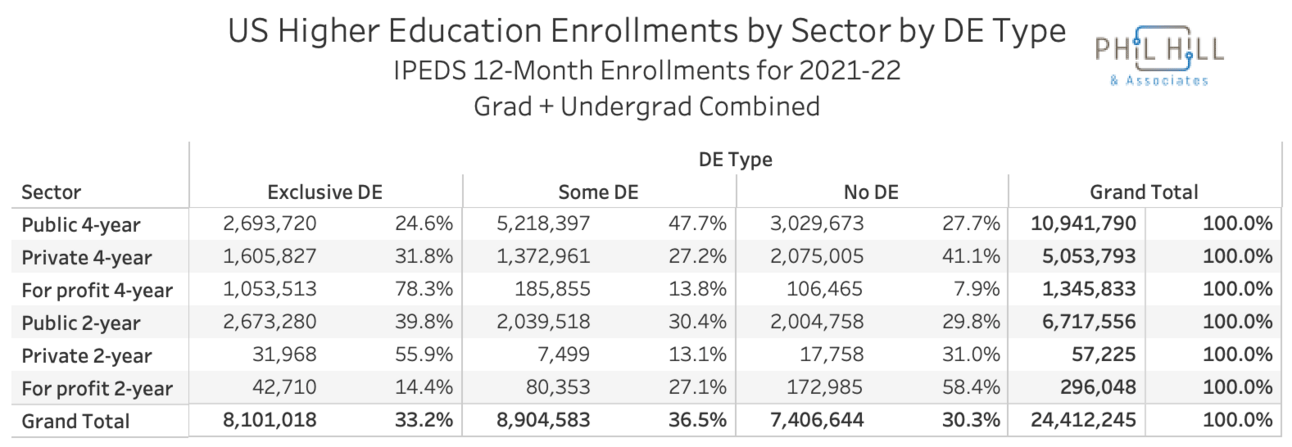2021-22 IPEDS Data: Profile of Late-Pandemic 12-Month Enrollments
SNHU takes over as largest US institution, plus pre- and late-pandemic comparison
I’ve covered the National Center for Education Statistic’s IPEDS data on distance education (i.e., online education) for the past 11 years, starting with this 2012 profile and continuing to the recent 2020 profile and analysis. *
IPEDS has been invaluable to researchers and analysts trying to understand these enrollment trends, but a well-known weakness is that the data come from the Fall Enrollment survey, which takes a census approach. How many students of each category as of the October census date (the 15th for most schools). This approach does not capture the increasingly important nature of multiple starts per year, shorter terms, and habits of part-time working-adult students. Students who take online courses in the winter, spring, or summer, but not in the fall, just don’t get counted, as the data approach originated with the assumptions of traditional start in the fall with a semester or quarter system programs.
Two years ago NCES added distance education classifications to their 12-month Enrollment survey which more accurately represents the true nature of online courses and programs. The basis of the survey is a count of how many unduplicated students fit within each category over a 12-month period, from July 1 through June 30 (in the current case from the 2021-22 academic year). Students working on flexible schedules that just don’t align with the October census dates.
This year gives us the chance to compare the final pre-pandemic numbers (2019-20) with essentially the end of the pandemic (2021-22).
For all of the following charts:
Exclusive DE: # or % of students taking only online courses in 2020-21
Some DE: # or % of students taking both online and face-to-face courses in 2020-21
No DE: # or % of students taking only face-to-face courses in 2020-21

Looking further at the data:
Overall, 33% of students in this period took only online courses, and a further 37% took a mix of online and face-to-face courses, totaling 70% of students taking at least some online courses (compared to 80% the year before).
These numbers show higher online entollments than the Fall 2021 data that showed 60% of students taking at least some online courses.
In terms of market concentration, the Top 50 (by exclusively DE enrollment) institutions pre-pandemic accounted for roughly 38% of all exclusively DE enrollments nationwide. By the end of the pandemic that number was just 31%, reflecting the large and wide adoption of online learning during the pandemic.
If we look at the top institutions by total enrollment, segmented by DE type, we see that Southern New Hampshire University (SNHU) has overtaken Western Governors University (WGU) as the largest US higher ed institution. SNHU has 224 k total students compared to WGU’s 214k, compared to two years ago when WGU had 190k students and SNHU 168k. For exclusive DE students SNHU is first, closely followed by WGU and then the former largest institution, the University of Phoenix.

Remember, this 12-month data better captures fully-online program enrollments than the fall census. This chart gives a better visual view of the mix of DE types.

What if we did the same chart but segmented it by the Degree Level (undergrad vs grad)?

While master’s level online programs are the sweet spot for the Online Program Management (OPM) market, and more broadly for institutions using revenue as a primary driver for online expansion, this chart shows visually that the number of undergraduate fully-online students is far larger than for graduate students. Graduate students are more likely to take exclusively online courses compared to undergraduate (44% vs. 31%, respectively) and pay higher tuition, but there are far fewer fully-online graduate students compared to undergraduate (1.8 m vs. 6.3 m).
And finally, two charts showing the changes from the 2019-20 to the 2021-22 academic year in terms of enrollments by sector (removing private and for profit 2-year sectors due to very low totals; bars showing total differences, labels as % change):

and by DE type:

* Reminder: IPEDS reports distance education (DE), although that is mostly equivalent to online education, and I’ll use the terms interchangeably.